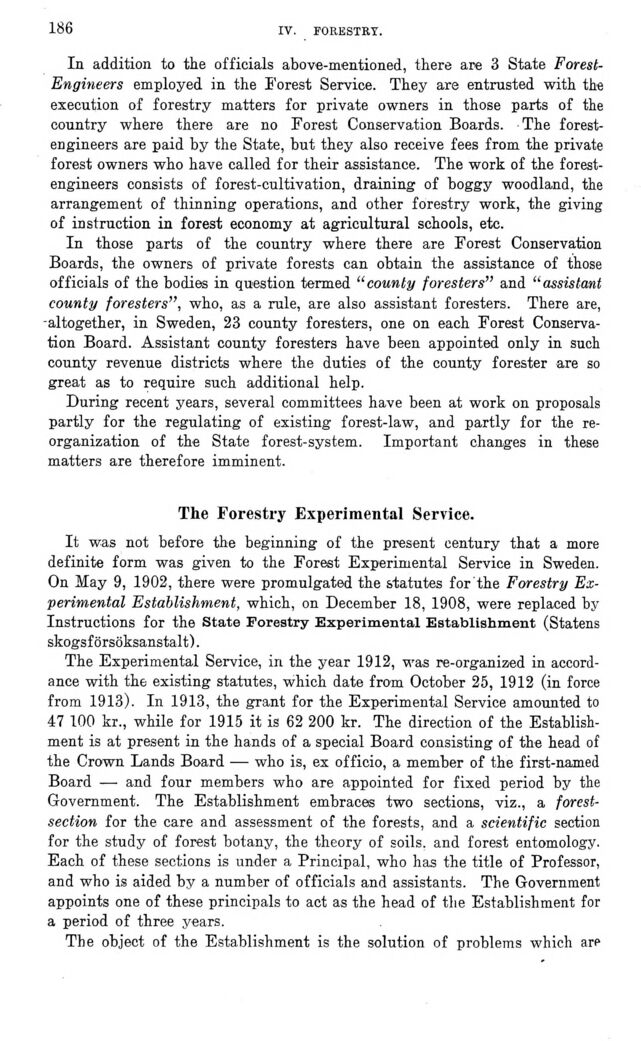
Full resolution (JPEG) - On this page / på denna sida - IV. Forestry - 1. Forests. By Th. Örtenblad

<< prev. page << föreg. sida << >> nästa sida >> next page >>
Below is the raw OCR text
from the above scanned image.
Do you see an error? Proofread the page now!
Här nedan syns maskintolkade texten från faksimilbilden ovan.
Ser du något fel? Korrekturläs sidan nu!
This page has never been proofread. / Denna sida har aldrig korrekturlästs.
186
iv. forestry.
In addition to the officials above-mentioned, there are 3 State
Forest-Engineers employed in the Forest Service. They are entrusted with the
execution of forestry matters for private owners in those parts of the
country where there are no Forest Conservation Boards. The
forest-engineers are paid by the State, but they also receive fees from the private
forest owners who have called for their assistance. The work of the
forest-engineers consists of forest-cultivation, draining of boggy woodland, the
arrangement of thinning operations, and other forestry work, the giving
of instruction in forest economy at agricultural schools, etc.
In those parts of the country where there are Forest Conservation
Boards, the owners of private forests can obtain the assistance of those
officials of the bodies in question termed 11 county foresters" and "assistant
county foresters", who, as a rule, are also assistant foresters. There are,
-altogether, in Sweden, 23 county foresters, one on each Forest
Conservation Board. Assistant county foresters have been appointed only in such
county revenue districts where the duties of the county forester are so
great as to require such additional help.
During recent years, several committees have been at work on proposals
partly for the regulating of existing forest-law, and partly for the
reorganization of the State forest-system. Important changes in these
matters are therefore imminent.
The Forestry Experimental Service.
It was not before the beginning of the present century that a more
definite form was given to the Forest Experimental Service in Sweden.
On May 9, 1902, there were promulgated the statutes for the Forestry
Experimental Establishment, which, on December 18, 1908, were replaced by
Instructions for the State Forestry Experimental Establishment (Statens
skogsförsöksanstalt).
The Experimental Service, in the year 1912, was re-organized in
accordance with the existing statutes, which date from October 25, 1912 (in force
from 1913). In 1913, the grant for the Experimental Service amounted to
47 100 kr., while for 1915 it is 62 200 kr. The direction of the
Establishment is at present in the hands of a special Board consisting of the head of
the Crown Lands Board — who is, ex officio, a member of the first-named
Board — and four members who are appointed for fixed period by the
Government. The Establishment embraces two sections, viz., a
forest-section for the care and assessment of the forests, and a scientific section
for the study of forest botany, the theory of soils, and forest entomology.
Each of these sections is under a Principal, who has the title of Professor,
and who is aided by a number of officials and assistants. The Government
appoints one of these principals to act as the head of the Establishment for
a period of three years.
The object of the Establishment is the solution of problems which are
<< prev. page << föreg. sida << >> nästa sida >> next page >>